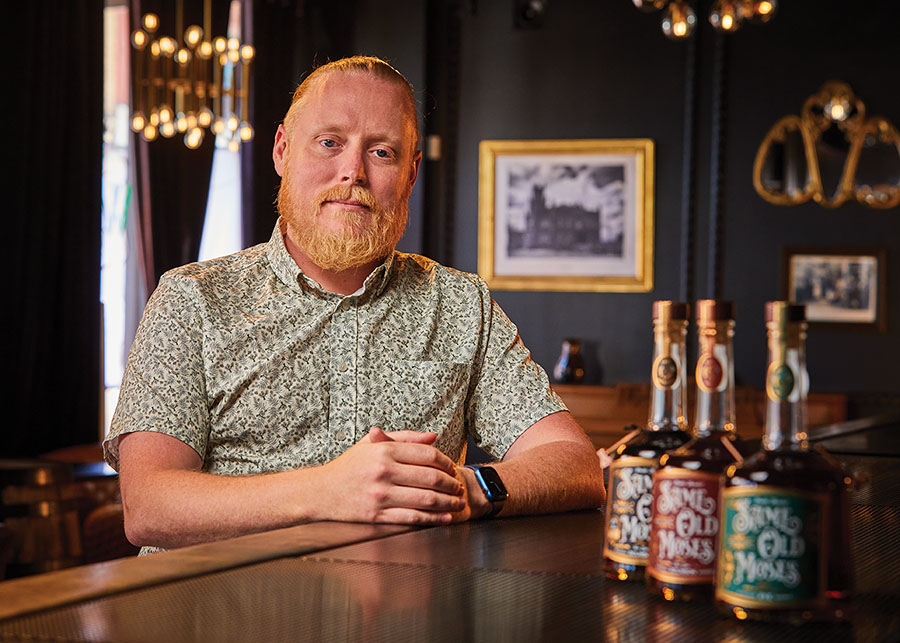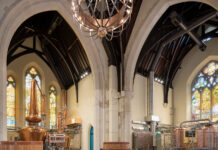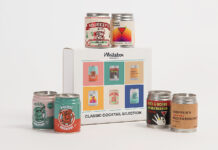
Photo by ashleyesser@gokrush.com.
Jeffrey Cole, distiller and director of spirits at WanderFolk Spirits, is a fifth-generation Oklahoman with a passion to grow his home state’s prominence in the spirits industry, where historically it has been low in sales and consumption. A 16-year career in craft spirits, wine, and cocktails/bars led him to WanderFolk, which houses three brands.
Cole has opened more than a dozen Oklahoma bars. That background, plus sommelier training, informs his palate, industry relationships, and ability to communicate to customers wherever they are. This is key to working in a state that wasn’t an early adopter of the craft spirits scene. Cole is also a founding member of the United States Bartenders’ Guild (USBG) Oklahoma City Chapter, where he served as its inaugural president for four years.
Oklahoma underwent pivotal alcohol law changes in 2018 that spurred Cole’s move to the supplier side. During the pandemic, he transitioned into management and distilling. He also co-founded the Oklahoma Distillers’ Guild and was elected its inaugural president. It’s a long way to come for someone whose initial dream was winemaking. In his own words, Cole tells us about his path to distilling and WanderFolk’s unique spirits.
Tell us about how you came to WanderFolk.
I was hired in 2018 as the sole salesperson for this small company. I provided some networking with my background in the Oklahoma bartending scene. Post-pandemic and the success of our hand sanitizer business, I wrote a letter to the owners which we now call the “Jerry Maguire letter.” Basically, I outlined my thoughts to improve the brand moving forward and create a meaningful business out of it which could transform spirits culture in Oklahoma forever.
The investors bit, reinvested in the company, restructured ownership and internal management, and promoted me to distiller/director of spirits, while adding a full-fledged sales team with GM/Sales and Marketing Director Derek Duty, and Director of Operations Daryn Vencl. Our company went from three brands under the Prairie Wolf [DSP] to WanderFolk Spirits, a branded house which has three brands: Same Old Moses, Garden Society, and Prairie Wolf.
What makes your spirits different from others?
Our spirits come from a place of authenticity to their styles with a little flair from my background as a tastemaker. I wanted to make world-class spirits in Oklahoma, and I wanted Oklahomans to care first before we looked beyond our borders. I wanted to give something to Oklahomans they could appreciate as something that is made by a guy that has experiences right here… In Oklahoma, we have a limited drinking culture. In terms of alcohol consumed per person, we’re in a battle for the bottom. Which is fine! That’s a lot of people to convert.
The Prairie Wolf line is just that. We want to make spirits accessible to Oklahomans. The price of entry to try these spirits is low, something we did on purpose to make the brand accessible to anyone and easy to reach for from a bar manager’s perspective. Something a retailer in Oklahoma could stock without worrying if they’d be able to pay for it. Prairie Wolf gin is made true to London Dry style in incredibly small batches with the best ingredients we can buy. This is a labor of love to get people that have written off the category [to give it] another chance. Our coffee liqueur is made at 30% ABV with only natural ingredients using locally owned El Salvadorian plantation-sourced coffee roasted here in Oklahoma and cold brewed using fantastic technology for a high TDS [total dissolved solids].
The Garden Society line was my first love. I convinced our investors to spend money on a fancy distillery consultant firm. That’s how I met my mentor, Steve Wright. Steve taught me large- and small-scale versions of creating gin, [and] set me loose with a technique to redistill every botanical I could get my hands on. I had about a year before any liquid needed to be in bottle. I was in heaven. After about eight months, I had a basic gin recipe. I discovered I was obsessed with making the perfect gin, something totally balanced. That’s when I discovered perfectly balanced gin isn’t what people want. People want to know what makes you different. I discovered this unique berry from Tasmania called mountain pepper while using a chef’s pairing app. I knew that flavor was unique enough to build a gin recipe from, so I went back to the drawing board and created something of a love letter to it. I was then tasked with making a flavored vodka. Left with an ego and a need to make a “gin that’s not a gin,” I set forth to make a simple botanical spirit using mountain pepper, lime peel, and lemon verbena: three of my favorite botanicals.
 Where is WanderFolk going now?
Where is WanderFolk going now?
Same Old Moses came last, viewed as something of a bridge to the future for us. Distilleries are being founded today with millions of dollars spent on huge facilities, beautiful stills, top-of-the line technology and automation, and out-of-the-gate notoriety. I didn’t have that. I came across a fellow Oklahoman who moved mountains in the beverage alcohol world. He worked directly for Sidney Frank back in the Grey Goose days and literally built a culture in the United States. I knew I wanted to have this guy as a mentor, and he happened to be in the middle of building a Texas bourbon empire. I spent time with him at his facility outside Austin, learning the perils of our region’s insane angel’s share, fermenting in midsummer, sourcing local grain, and untold other experiences.
I decided to start our whiskey portfolio by sourcing from him and finishing all his whiskeys in Oklahoma. In my time as a beverage director, I worked for [an OKC] gentleman who owns one of the largest collections of single malts in the world… I got to experience whiskeys, meet people, travel, and learn techniques from master blenders he is friends with firsthand. Paired with my background in wine as a sommelier, I hunted down my first purveyor of fine wood with the idea that I, like my Scottish brethren before me, would show the world what whiskeys from our region could taste like with a little influence from various wine and brandy casks. The Same Old Moses line takes two whiskeys, a rye and a bourbon, finishes them in various casks from France, Italy, Spain, and Portugal, and 100% new oak sourced from the same cooper the whiskeys aged in originally. I’ve taken sourcing and used it to learn about maturation in an area that has zero scientific knowledge of what will occur in barrel in our climate.
The future is grain-to-glass. We have 300 barrels of bourbon we started laying down in December 2021 using Oklahoma grain. I’m in the middle of several years of barley-growing experimentation in Oklahoma. Last year’s harvest wasn’t great for beer, but will be a good distillers’ barley, something with a high diastatic power but not great plumpness. This year’s weather made for excellent brewing barley, something I’m sending to be toll malted at a partner maltster for use around the state, to gauge interest in local malt from farmers, brewers, and distillers. Rye is an important and often overlooked crop in Oklahoma. One of the best varieties you will see in experimentation, Oklon, comes from here. We’re spending every extra moment we have to make distilling matter in Oklahoma, not just for us, but for the economy and culture.
How does running a distillery in OKC inform your business and style?
First, we aren’t really in OKC. We’re in the original capital of Oklahoma, Guthrie, about 30 miles north. But I can still speak to how much interstate travel means to us. Opening a distillery in Oklahoma, on paper, looks like a terrible idea. All package stores are independently owned with a two-store-per-person cap, which means you get no network of sales from speaking to one guy who might manage several stores.
But in terms of locally owned restaurants, we’re killing it. We have an amazing food and drink scene, and they’re really what moves the needle for us. We spend a ton of time and resources on education, bringing staff to Guthrie for tours, building custom gins, and doing workshops to get people involved and give them a sense of ownership. Our distribution partner is another huge piece of the puzzle. We’re so fortunate in Oklahoma to have multiple amazing distributors at that smaller level, and we work extremely closely with ours… We’re also hamstrung with some interesting liquor laws. If you visit our tasting room today, you can buy all the bottles you want, sample anything, buy pours. But I, as a bartender, am not allowed to mix a cocktail for you. My work-around is to make a mocktail which you, the customer, can add our spirit to on your own. It has been beneficial. Every interaction with a guest is a conversation.
What do you feel are the key elements of getting your brand placed?
This depends a lot on where you are state-wise. I can speak mostly to Oklahoma, but I think a lot of these transcend borders. We actively ask for the sale. We don’t make any bones about who we are… All our sales guys and distributor reps can communicate who we are and what we do effectively — with pride, which is key.
We’re involved with the community of folks selling our stuff. The customers of our customers. In the end, our only customer is the distributor. But nothing can beat telling your own story. We have dedicated sales reps in every major market we’re in. These aren’t just any sales reps. They’re mostly guys I met through my years as a working bartender. As a matter of fact, most of our sales team are ex-bartenders and founding USBG members. These guys can speak confidently about all spirits, including those we don’t make.
Our brand story is incredibly important to all of us. Being able to articulate why we do things, why a brand is called what it’s called, why we use certain ingredients, and what all of it means to the story. And standing behind the products once accounts have made the purchase. We help on- and off-premise accounts strategizing how to sell our products: menu creation, events, recipe development, hand-selling, shelf placement, and knowing the customer’s [pet peeves and needs].
How do you envision the world of craft distilling evolving in coming years?
I think the world is getting smaller. I look to our brewery friends here in Oklahoma to see how their customers affect them. In OK, we went from 0 to 80 craft breweries in 20 years. Distilleries are slower to develop, but I think similar. Craft breweries are lumped sort of into two categories: self-distributing and dependent on tap rooms, and those which are more regional and dependent on a distributor. They each have two separate problems and business plans.
Right now, in the distillery world, there are many craft distilleries opening with these non-craft, huge facility budgets which will require a distributor partner. There just aren’t that many distributors to go around. I think we will see more small distilleries outperform bigger, new guys in terms of becoming profitable. Being nimble is such an overlooked advantage smaller distilleries have over massive new distilleries. I see distilleries trying to come up with more inventive ways to get people to their tasting rooms en masse. Being able to create more products for people that are by nature early adopters, but maybe don’t buy the same bottle over and over.








